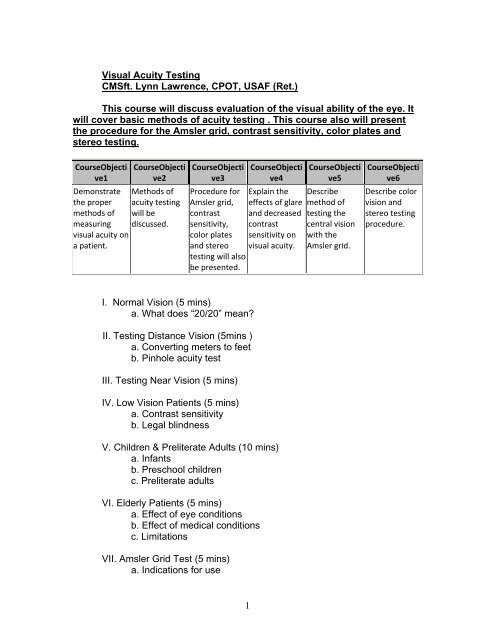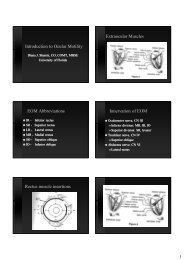1 Visual Acuity Testing CMSft. Lynn Lawrence, CPOT ... - SECO 2011
1 Visual Acuity Testing CMSft. Lynn Lawrence, CPOT ... - SECO 2011
1 Visual Acuity Testing CMSft. Lynn Lawrence, CPOT ... - SECO 2011
You also want an ePaper? Increase the reach of your titles
YUMPU automatically turns print PDFs into web optimized ePapers that Google loves.
<strong>Visual</strong> <strong>Acuity</strong> <strong>Testing</strong><br />
<strong>CMSft</strong>. <strong>Lynn</strong> <strong>Lawrence</strong>, <strong>CPOT</strong>, USAF (Ret.)<br />
This course will discuss evaluation of the visual ability of the eye. It<br />
will cover basic methods of acuity testing . This course also will present<br />
the procedure for the Amsler grid, contrast sensitivity, color plates and<br />
stereo testing.<br />
CourseObjecti<br />
ve1<br />
CourseObjecti<br />
ve2<br />
Demonstrate Methods of<br />
the proper acuity testing<br />
methods of will be<br />
measuring<br />
visual acuity on<br />
a patient.<br />
discussed.<br />
CourseObjecti<br />
ve3<br />
Procedure for<br />
Amsler grid,<br />
contrast<br />
sensitivity,<br />
color plates<br />
and stereo<br />
testing will also<br />
be presented.<br />
I. Normal Vision (5 mins)<br />
a. What does “20/20” mean?<br />
II. <strong>Testing</strong> Distance Vision (5mins )<br />
a. Converting meters to feet<br />
b. Pinhole acuity test<br />
III. <strong>Testing</strong> Near Vision (5 mins)<br />
IV. Low Vision Patients (5 mins)<br />
a. Contrast sensitivity<br />
b. Legal blindness<br />
1<br />
CourseObjecti<br />
ve4<br />
Explain the<br />
effects of glare<br />
and decreased<br />
contrast<br />
sensitivity on<br />
visual acuity.<br />
V. Children & Preliterate Adults (10 mins)<br />
a. Infants<br />
b. Preschool children<br />
c. Preliterate adults<br />
VI. Elderly Patients (5 mins)<br />
a. Effect of eye conditions<br />
b. Effect of medical conditions<br />
c. Limitations<br />
VII. Amsler Grid Test (5 mins)<br />
a. Indications for use<br />
CourseObjecti<br />
ve5<br />
Describe<br />
method of<br />
testing the<br />
central vision<br />
with the<br />
Amsler grid.<br />
CourseObjecti<br />
ve6<br />
Describe color<br />
vision and<br />
stereo testing<br />
procedure.
VIII. Color Vision <strong>Testing</strong> (5 mins)<br />
a. Monocular vs. binocular<br />
b. Genetic vs. acquired<br />
IX. Stereo <strong>Testing</strong> (5 mins)<br />
a. Binocular vision<br />
b. Suppression<br />
<strong>Visual</strong> <strong>Acuity</strong> Measurement<br />
� Essential part of an ocular examination<br />
� Requires:<br />
• Detection of the object<br />
• Resolving the object into component parts<br />
• Transmitting the information to the brain<br />
• Matching against existing memory shapes<br />
• Communication of recognition<br />
<strong>Acuity</strong> Charts<br />
� Rows of different size letters<br />
� Each subtending the same visual angle at a specified distance up to 20 feet<br />
The Snellen Chart<br />
� Developed 1863 by Professor Snellen<br />
� Accepted as standard<br />
The Snellen Chart: Disadvantages<br />
� Some letters are easier to recognize (ex: L is easier than E)<br />
� Patients must be literate; modifications include the Landolt rings and tumbling E<br />
chart<br />
� Different numbers of letterson each line and nonproportional spacing between<br />
letters<br />
Bailey-Lovie Chart<br />
�� Early Treatment Diabetic Retinopathy Study (ETDRS)<br />
� Progressive linear assessment of acuity<br />
� Has become the standard for clinical research<br />
2
� Each row has 5 letters<br />
� Read at 4 meters<br />
• <strong>Acuity</strong> of 1.0=20/200<br />
• <strong>Acuity</strong> of 0.3=20/40<br />
• <strong>Acuity</strong> of 0.0=20/20<br />
Pinhole<br />
� Should be done if vision is 20/40 or less<br />
� Allows only parallel rays from the object into the eye<br />
Converting Meters to Feet<br />
� 1 m = 3.28 ft.<br />
� Divide denominator by 3<br />
• 6/6 = 20/20<br />
• 6/9 =20/30<br />
Partially Sighted<br />
� Best corrected visual acuity of 20/60 or worse in the better eye<br />
Legal Blindness<br />
� Best corrected eye is 20/200<br />
� Field of vision in the better eye is less than 20 degrees<br />
Low Vision Charts<br />
� Feinbloom Chart<br />
� Calibrated for use at 10 feet<br />
3
Contrast Sensitivity<br />
� In the “real world” the eye responds to levels of luminance of a target and its<br />
background.<br />
� Snellen acuity charting does not reflect how the individual can visually function<br />
when:<br />
• driving at night<br />
• reading in poor light<br />
• in direct sunlight<br />
Contrast Sensitivity <strong>Testing</strong><br />
� Sine wave gratings<br />
• Electronically on a television screen<br />
• Graphically on a chart<br />
� Pelli-Robson Chart<br />
• Common method of measuring contrast sensitivity<br />
• Letter tests usually give better results than sine gratings<br />
Infants<br />
�� Fix & Follow (F&F)<br />
�� Central, Steady, Maintained (CSM)<br />
�� Response to Light (+/-)<br />
� Opticokinetic Nystagmus Drum (OKN)<br />
� Preferential viewing<br />
�� VEP<br />
Pre-School Children<br />
� Allen picture cards<br />
� Tumbling E’s<br />
� HOTV<br />
4
Elderly Patients<br />
�� <strong>Testing</strong> the vision of an elderly patient may require more time due to medical<br />
conditions such as:<br />
• Dry eye<br />
• Macular degeneration<br />
• Floaters<br />
• Decreased contrast sensitivity<br />
• Hard of hearing<br />
• Confusion<br />
Amblyopic Patients<br />
�� Watch carefully for peeking<br />
�� Test amblyopic eye first<br />
�� Crowding Phenomenon: single optotype<br />
Patients with Nystagmus<br />
� Do not occlude<br />
� Use a high plus lens to fog the eye not being checked<br />
Listen to What the Patient Says<br />
� “I can only see the letters on the left/right side.”<br />
� Important to “push” the patient to the next line to determine if a pattern is<br />
developing.<br />
Factors Other Than Disease That Can Affect <strong>Visual</strong> <strong>Acuity</strong><br />
� Uncorrected ametropia<br />
� Eccentric viewing<br />
� Decreased contrast<br />
� Large (> 6mm) or small (< 2mm) pupils<br />
� Young or old age<br />
� Adults<br />
• Monetary Gain<br />
• Attention<br />
• Psychiatric Condition<br />
� Children<br />
• Want glasses<br />
• Reaction to stress/emotional problem<br />
• Attention<br />
Psychological Factors That May Affect Test Results<br />
� Attention<br />
5
� Motivation<br />
� Intelligence<br />
Stereo <strong>Testing</strong><br />
� Should be done prior to visual acuity testing<br />
Amsler Grid<br />
� Tests the central 20 degrees (macula)<br />
� Each square subtends an angle of 1 0<br />
• Macular Degeneration<br />
• Diabetic Retinopathy<br />
Pseudoisochromatic Plates (PIP’s)<br />
� Ishihara<br />
• 14, 24, or 38 plates<br />
• Plate #1 can be read by anyone, even those with color defects<br />
� Hardy-Rand Ritter (HRR)<br />
• Screening test to separate those with defective color vision from those<br />
with normal color vision<br />
• Classifies the type of defect<br />
• Indicates the extent of the defect (mild, medium, strong)<br />
Farnsworth D-15<br />
� Used to separate medium and strong color defect vs. normal<br />
Color Vision <strong>Testing</strong> Environment<br />
� Well-lit room<br />
� Natural daylight, without direct sunlight<br />
� MacBeth Illuminant C lamp<br />
� Filtered tungsten halogen light source to provide the most accurate simulation of<br />
natural daylight<br />
<strong>Testing</strong> Procedures-Children<br />
� Allow child to trace the color with a Q-tip or paintbrush.<br />
� Do not allow the patient to touch the discs with their hands, as dirt and oil can<br />
discolor the plates.<br />
6




